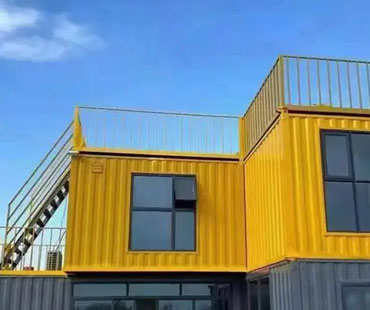In an era defined by rapid urbanization, fluctuating housing demands, and a growing emphasis on sustainable living,expandable homes have emerged as one of the most innovative architectural solutions. These mobile, foldable, and modular housing systems seamlessly mergeengineering efficiency withenvironmental responsibility, offering flexibility, affordability, and modern comfort. As the world continues to rethink the future of living spaces, expandable homes represent the perfect balance betweendesign innovation and energy conservation.
1. The Concept of Expandable Homes
An expandable home is a prefabricated structure that canexpand or fold to increase or reduce its living area as needed. Typically, these homes are designed to be easily transported and quickly installed at various locations — from urban rooftops and suburban plots to remote construction sites or disaster relief zones.
Unlike traditional houses, expandable homes rely onmodular engineering, where components are pre-manufactured in controlled factory environments. This process ensuresprecision, reduced waste, and higher construction quality, while also minimizing on-site labor and environmental disruption.
The appeal of expandable homes lies in theirversatility: they can serve as residential units, temporary offices, medical shelters, tourism cabins, or even mobile classrooms. The flexibility of expansion allows users to adapt the space according to personal or situational needs, redefining how we think about home ownership and spatial use.
2. Innovative Structural Design: Strength and Adaptability Combined
The engineering design of expandable homes reflects a fine balance betweenmobility and durability. Unlike typical mobile homes or trailers, these units are built usinglightweight yet strong materials, such as high-tensile steel, aluminum alloys, and composite sandwich panels.
Key design innovations include:
(1.Telescopic and Folding Mechanisms
Expandable homes use mechanical or hydraulic systems that allow walls, floors, and ceilings to extend outward. This design ensures that a compact unit can transform into a spacious living area within minutes, offering up tothree times the space of its folded state.
(2.Modular Frame Construction
The frame structure is designed to withstand transportation stress while maintaining stability after deployment. Reinforced joints and load-bearing panels provide excellentanti-seismic andwind-resistant performance, essential for outdoor or off-grid applications.
(3.Integrated Utilities System
Modern expandable homes incorporateplug-and-play electrical, plumbing, and HVAC systems, pre-installed during manufacturing. This not only simplifies setup but also guarantees consistent safety and efficiency standards.
(4.Insulation and Acoustic Optimization
The use of high-density polyurethane insulation panels and sound-absorbing materials ensures thermal stability and quiet indoor environments — vital for both energy conservation and occupant comfort.
Through such designs, expandable homes achievemaximum usability with minimum structural complexity, proving that innovation in housing doesn’t have to come at the cost of comfort or stability.

3. Energy-Saving and Sustainability Features
One of the strongest appeals of expandable homes lies in theireco-friendly and energy-efficient attributes. As global awareness of climate change increases, homeowners and developers are looking for solutions that reduce carbon footprints and operational costs. Expandable homes meet this demand through several smart design strategies:
(1.Passive Energy Efficiency
The orientation of windows, roofs, and ventilation systems is often optimized to capture natural light and enhance airflow. This reduces reliance on artificial lighting and mechanical cooling, cutting energy consumption by up to 30–40%.
(2.Renewable Energy Integration
Many expandable homes come equipped withsolar panels, inverters, and energy storage systems, allowing full or partial off-grid operation. This independence makes them ideal for remote areas or eco-conscious communities.
(3.Sustainable Materials
The use of recyclable metals, low-VOC paints, and environmentally friendly insulation materials reduces construction pollution and supports circular economy principles.
(4.Smart Energy Management Systems
IoT-based monitoring systems track electricity and water usage in real-time, automatically adjusting lighting, temperature, and ventilation for optimal efficiency.
(5.Water Recycling and Green Roofing
Some designs incorporate greywater recycling systems and roof gardens that not only improve aesthetics but also contribute to heat insulation and air purification.
Collectively, these innovations transform expandable homes intoself-sustaining micro-ecosystems, capable of maintaining comfort while significantly reducing ecological impact.
4. Practical Applications Across Industries
Expandable homes are not just a futuristic concept — they’re being actively adopted across multiple sectors:
Residential Housing: Providing affordable, modular solutions for young homeowners, retirees, or families seeking flexible space options.
Tourism & Hospitality: Offering quick-deploy luxury cabins, glamping units, and eco-lodges that blend seamlessly into natural environments.
Disaster Relief & Humanitarian Aid: Rapid deployment after earthquakes, floods, or other crises, providing safe and dignified temporary housing.
Commercial & Industrial Use: Serving as on-site offices, laboratories, or worker accommodations in remote construction or mining projects.
Government & Education: Used as mobile clinics, classrooms, or emergency command centers where infrastructure is limited.
This versatility demonstrates the adaptability of expandable housing technology, bridging the gap betweentemporary functionality and long-term sustainability.
5. The Future of Expandable Housing Design
As material science, AI, and smart manufacturing continue to advance, the future of expandable homes will emphasizeautomation, digital control, and environmental integration. Future models are expected to include:
AI-assisted deployment systems, allowing homes to unfold automatically with minimal human input.
Self-regulating energy grids, enabling seamless solar energy management and battery optimization.
3D-printed structural components, reducing material waste and enabling mass customization.
Hybrid modular integration, allowing units to connect vertically or horizontally to create expandable communities or eco-villages.
These innovations point toward a world where housing is no longer static — instead, it adapts, evolves, and interacts with its environment.
Expandable homes represent a powerful convergence ofarchitecture, sustainability, and smart engineering. Their design philosophy — to do more with less — perfectly encapsulates the values of a generation that prioritizes mobility, efficiency, and environmental consciousness.
By combining structural ingenuity with energy-saving technologies, these homes provide a glimpse into the future of housing: one that ismodular, mobile, and mindful. As more individuals, businesses, and governments recognize their potential, expandable homes will undoubtedly play a vital role in reshaping how we build and live in the 21st century.


